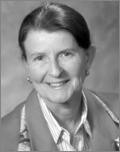202nd ECS Meeting | Salt Lake City, UT | Oct. 21, 2002

New Chemical Technologies – The Dow Perspective
Carol Jensen, vice-president of global R&D for The Dow Chemical Co., presented the plenary lecture on Monday morning, entitled, “New Chemical Technologies – The Dow Perspective.” She noted that the historical beginnings of the company were in the electrolytic manufacture of bromine from brine by Herbert Dow in 1890. (See Interface, spring 2002, p. 23). The company’s charter was to bridge academia, research, and engineering; with the Dow-Union Carbide merger, the largest chemical enterprise in the world was born.
Dr. Jensen noted that the Performance Chemicals and Plastics Division accounted for $12.4 billion out of $27.8 billion total revenue. Approximately one billion dollars (U.S.) was earmarked for R&D in this area, and a measure of the return of investment was the award of the National Medal of Technology to Dow in June 2002. Dr. Jensen divided her talk on R&D activities at Dow into three parts: “Old” (polyethylene), “New” (electronic materials), and the “Next” frontier (biotechnology).
In the first category, Dr. Jensen cited the development by Dow of the singlesite INSITETM catalyst for olefin polymerization. She contrasted this newgeneration catalyst with the classical Ziegler-Natta counterpart. Finally, she pointed out the many applications of polyolefins in the automobile, packaging, wire-coating, and health industries.
In the area of electronic materials, Dr. Jensen noted the emerging need for low dielectric constant (k) materials as the insulator in the modern-day fast, ultra-small, and cheap integrated circuits. She cited Dow’s contributions in this area on the development of new families of fluorocarbon-based dielectrics (SiLK) with k values in the 2.1 to 2.6 range. An important innovation was the preparation of porous SiLK dielectrics where air filling of the matrix serves to further lower the k value. Another class of materials under development at Dow are light-emitting diode (LED) materials. Here the target is brighter and more energy-efficient (lowpower) devices based on organic active components. Long-term stability and multi-color emissive capability were mentioned as challenges in this area.
The next frontier of Dow R&D is biotechnology. Here the company focus is moving chemical synthesis from huge plants (mostly-petroleum based) to cellular factories. Dr. Jensen noted that conventional chemical synthesis (based largely on the petrochemical sector) is inelegant and uses non-renewable resources (fossil fuels), compared with what cellular organisms can do with natural precursors. The biotechnology R&D activities at Dow are organized into plant, pharmaceutical, and industrial categories. Jensen also pointed out the contributions of Dow to the agro-chemical sector, particularly in the area of insect/pest control and the development of natural, low-toxicity chemicals. Dr. Jensen ended her informative and fastpaced lecture with a reiteration of the Dow motto, “It’s all about innovation.”
